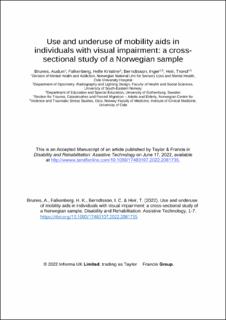| dc.contributor.author | Brunes, Audun | |
| dc.contributor.author | Falkenberg, Helle Kristine | |
| dc.contributor.author | Berndtsson, Inger | |
| dc.contributor.author | Heir, Trond | |
| dc.date.accessioned | 2023-04-21T07:34:24Z | |
| dc.date.available | 2023-04-21T07:34:24Z | |
| dc.date.created | 2022-07-25T10:38:57Z | |
| dc.date.issued | 2022 | |
| dc.identifier.citation | Brunes, A., Falkenberg, H. K., Berndtsson, I. C. & Heir, T. (2022). Use and underuse of mobility aids in individuals with visual impairment: a cross-sectional study of a Norwegian sample. Disability and Rehabilitation: Assistive Technology, 1-7. | en_US |
| dc.identifier.issn | 1748-3107 | |
| dc.identifier.uri | https://hdl.handle.net/11250/3064154 | |
| dc.description.abstract | Purpose: To examine the use and underuse of mobility aids in individuals with visual impairment.
Methods: A telephone survey including a probability sample of 736 adults who were members of the Norwegian Association of the Blind and Sighted (response rate: 61%). The interviews took place between January and May 2017, collecting information about access, use, underuse and training in five types of mobility aids (white cane, guide dog, GPS, door-to-door transport and sighted guide). For each mobility aid, we obtained data for underuse defined as non-use despite expecting benefits of use in terms of increased mobility or safety. Participants also answered questions about loneliness (Three-Item Loneliness Scale) and life satisfaction (Cantril’s Ladder of Life Satisfaction).
Results: Of the participants, 69% reported using at least one type of mobility aid. Use of specific aids ranged from 12% for the GPS to 52% for door-to-door transport. Estimates of underuse ranged between 14% for door-to-door transport and 28% for GPS. Underuse was not related to lack of resources, as many non-users expecting benefits had access to mobility aids and had undergone training in its use. For example, 81% of non-users of the white cane had access to a cane. In post hoc analyses, non-users who expected benefits from use had lower life satisfaction compared with users.
Conclusions: Many individuals with visual impairment do not use mobility aids. Strategies that help visually impaired individuals overcome barriers to the use of mobility aids may improve their sense of safety, mobility and quality of life. | en_US |
| dc.language.iso | eng | en_US |
| dc.title | Use and underuse of mobility aids in individuals with visual impairment: a cross-sectional study of a Norwegian sample | en_US |
| dc.type | Peer reviewed | en_US |
| dc.type | Journal article | en_US |
| dc.description.version | acceptedVersion | en_US |
| dc.rights.holder | © 2022 Informa UK Limited, trading as Taylor & Francis Group. | en_US |
| dc.source.pagenumber | 7 | en_US |
| dc.source.journal | Disability and Rehabilitation: Assistive Technology | en_US |
| dc.identifier.doi | https://doi.org/10.1080/17483107.2022.2081735 | |
| dc.identifier.cristin | 2039297 | |
| cristin.ispublished | true | |
| cristin.fulltext | original | |
| cristin.qualitycode | 1 | |
